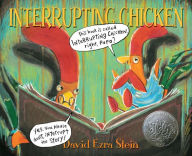

Can you imagine a world where all of us were active listeners and we never interrupted each other? Interrupting is a hard habit to break, so it’s worth the effort to teach our children and students not to interrupt before those bad habits develop.
I found two children’s books that communicate the non-interrupting message, but have great illustrations and are fun to read. Maybe you can use them in your home or classroom.
The first is Interrupting Chicken by David Ezra Stein. It received a Caldecott Honor in 2011. This picture book is about story time in a chicken household. Papa reminds his little chick not to interrupt, but she can’t help herself. She jumps in on every familiar fairy tale he reads, trying to save the characters from doing something dangerous or silly. When it’s finally the chick’s turn to tell a story, Papa does his own kind of interrupting.
A second helpful book is My Mouth is a Volcano written by Julia Cook and illustrated by Carrie Hartman. A little boy named Louis has thoughts that just erupt out of his mouth, interrupting others. He learns a technique to capture his thoughts and respect others by listening and waiting for his turn to speak.
Reading books like these about interrupting may make a longer-lasting impression than a lecture alone. You may need to read them over and over, but you’re developing a mindset that friends and family will appreciate for years to come. (And soon you may be able to get through each book without being interrupted!)

